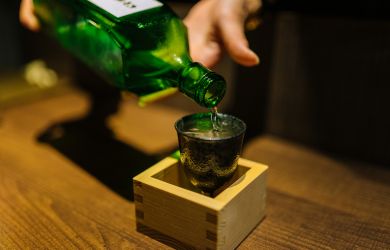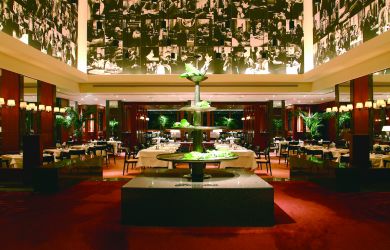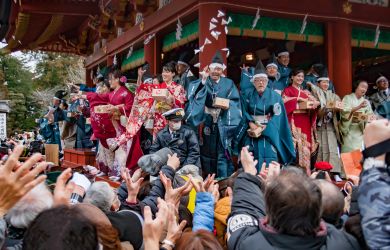
October 12, 2012
Welcome to the Retrozone
The Tokyo Station Hotel is the centerpiece of Tokyo’s time-warp district
By Metropolis
Originally published on metropolis.co.jp on October 2012


Amid much fanfare a grand new hotel opened earlier this month as part of the refurbishment of Tokyo Station. Yet “new” isn’t quite correct, as The Tokyo Station Hotel opened in 1915 and saw more than 90 years of service until 2006 when it closed for major refurbishment. “Old” isn’t the right word either. The redesign has three times as many rooms as the original, a state-of-the art spa, and an interior design concept blending classic and modern European features.
On its own, The Tokyo Station Hotel is a wonderful iconic building in a city that badly needs them. It also stands out in Japan as an early example of a Western-style building designed by a native architect, and has important literary associations. The hotel served as inspiration for the famous novels Niju Menso by Rampo Edogawa and Abo Ressha by Hyakken Uchida and was a favorite haunt of other famous writers like Seicho Matsumoto and Nobel Prize-winner Yasunari Kawabata.
But the hotel is also a gateway to one of Tokyo’s most architecturally fascinating districts. Its blend of old and new is typical of Marunouchi, the prime strip of real estate stretching from Tokyo station to the Emperor’s Palace.
After a period when ugly modernism triumphed, the implementation of a new city planning system, the reduction of tax burdens, and the provision of subsidies encouraged the preservation of historic buildings to maintain the character and vitality of the area. The area’s architecture reveals this fascinating narrative: a conflict between past and present, between the urge to sweep away old buildings and conserve them, a struggle that gradually evolved into a synergy that seeks the best of both worlds.
2
Times the building has reopened after a lengthy renovation. It closed for repairs in 1945, after being damaged in the war, reopening in 1951
150
En suite rooms divided into six different types: classic, place side, dome side, maisonette, suite, and royal suite
475
Seats in all the hotel’s bars, restaurants, and cafés
23
Size in m2 of the smallest room, at ¥30,030/night
¥808,500
Price per night of largest room, the 173m2 royal suite
3,000
Approximate number of trains per day at Tokyo station
A fine example is the Mitsubishi Ichigokan Building, now home to the museum of the same name. To the naked eye this looks a rather well-preserved, late-Victorian building, but in reality the structure was constructed entirely from new building materials in 2009. Its only archaic aspect is the architectural plan—the same blueprints used to create an almost identical building which stood on the same site from 1894 to 1968. The English architect, Josiah Conder (1852–1920), was headhunted by the Japanese government in order to introduce “modern” architectural methods to Meiji-period Japan. In addition to designing buildings, he also taught the first generation of modern Japanese architects, including Kingo Tatsuno, architect of the The Tokyo Station Hotel.
Another hybrid of antiquated and cutting edge in the neighborhood is the Mitsubishi UFJ Trust and Banking Building. This metal and glass monster was developed in conjunction with the preservation of the Club House of the Industry Club of Japan, a 1920s building that adds a much needed touch of elegance to the larger building. Then there is the DN Tower 21, a modern office tower joined to the historic Dai-Ichi Seimei Building, which served as General Douglas MacArthur’s HQ during the US occupation of Japan.
The recent evolution of Marunouchi is part of an area plan including nearby Otemachi and Yurakucho, known as the OMY area. Shigenori Kobayashi, chairman of the OMY Area Management Association emphasizes the need to create an environment attracting people and steady revenue rather than the speculative capital that has been the blight of other neighborhoods. Part of their work is founded on recognizing differences from area to area and the complex ways these interact. Kobayashi explains that “Otemachi, the financial center, is zoned for skyscrapers. The Tokyo Station side of Marunouchi is zoned for relatively tall buildings, and the Imperial Palace side of Marunouchi is zoned for low-rise buildings.” He also explains that Yurakucho’s distinct urban character resulted in a commitment to “maintain its differences and preserve its disordered spaces.”

One of the problems financial districts have is that they can become dead and uninviting after business hours. The association has also worked to combat this problem. “Marunouchi’s Naka-dori used to be lined with banks, so it was always deserted after 3pm,” Kobayashi recalls. “We transformed it by introducing a number of boutiques and by providing an open public space on the Marunouchi side, thereby establishing design rules to revitalize the area.”
With The Tokyo Station Hotel providing a new focus for the district, the revitalization looks set to continue.
the secret history of marunouchi
A clue to how Marunouchi became the most prestigious business district in Japan can be found in its name. Literally meaning “inside the circle,” it refers to its location within the outer moat of Edo Castle. During the Edo period (1603–1868) the area was occupied by the homes of important daimyo (lords), especially hereditary vassals or relatives of the ruling Tokugawa clan.

After the Meiji Revolution, it was thought necessary to provide the Emperor, who had just moved to Tokyo, with a strong guard because the city was still considered too sympathetic to the old order. So, while the present Imperial Palace was being constructed on the site of Edo Castle and the Emperor was staying in a provisional palace in nearby Akasaka, the daimyo residences in Marunouchi were converted into barracks for the Imperial Guard.
But this policy backfired on the night of August 23, 1878, when the Artillery Corps of the Imperial Guard, angered by pay reductions and reorganization, rose in mutiny. This uprising, which became known as the Takebashi Incident, posed a serious threat to the Emperor and the government. At one point, the mutineers, who had cannon, shot at government buildings and were dangerously close to seizing the provisional Imperial Palace before they were stopped by loyal infantry units. A total of 394 officers and soldiers were punished, including 55 who were executed.
After this chastening lesson, it was decided to move the barracks far from the Palace to a new site in Azabu. The vacated land, present-day Marunouchi, remained in government hands until 1890, when Yanosuke Iwasaki, the second president of the Mitsubishi Corporation, decided to buy it in one of the greatest real estate coups ever. The area purchased was 280,000m2 in area, stretching about 1,500m north-to-south and about 200m east-to-west. This momentous decision was taken by Iwasaki while on a business trip to Glasgow in Scotland, from where he sent the telegram authorizing the purchase.
Influenced by his travels abroad, Iwasaki was set on creating a European-style business district for Tokyo, with elegant, modern buildings, and wide streets. This led him to employ the English architect Josiah Conder to build the Mitsubishi Ichigokan (“Number One”) Building. This set the tone, and soon further buildings in the Western style appeared, leading to the area being nicknamed “Iccho London” (one-block London). This style also carried over into the Tokyo Station Building, built in 1914, which set the seal on the area’s formation.
Compared to other parts of Tokyo, the area fared reasonably well in the Tokyo Earthquake of 1923 and the US firebombing in 1945, with the US occupation authorities setting up headquarters in the relatively undamaged Dai-Ichi Seimei Building. The area’s greatest challenge came during the period of rapid post-war economic growth, when much of the elegance of the area was lost in the rush to expand office capacity. However, due to the proximity of the Imperial Palace, height restrictions helped push a lot of destructive redevelopment into other zones.





